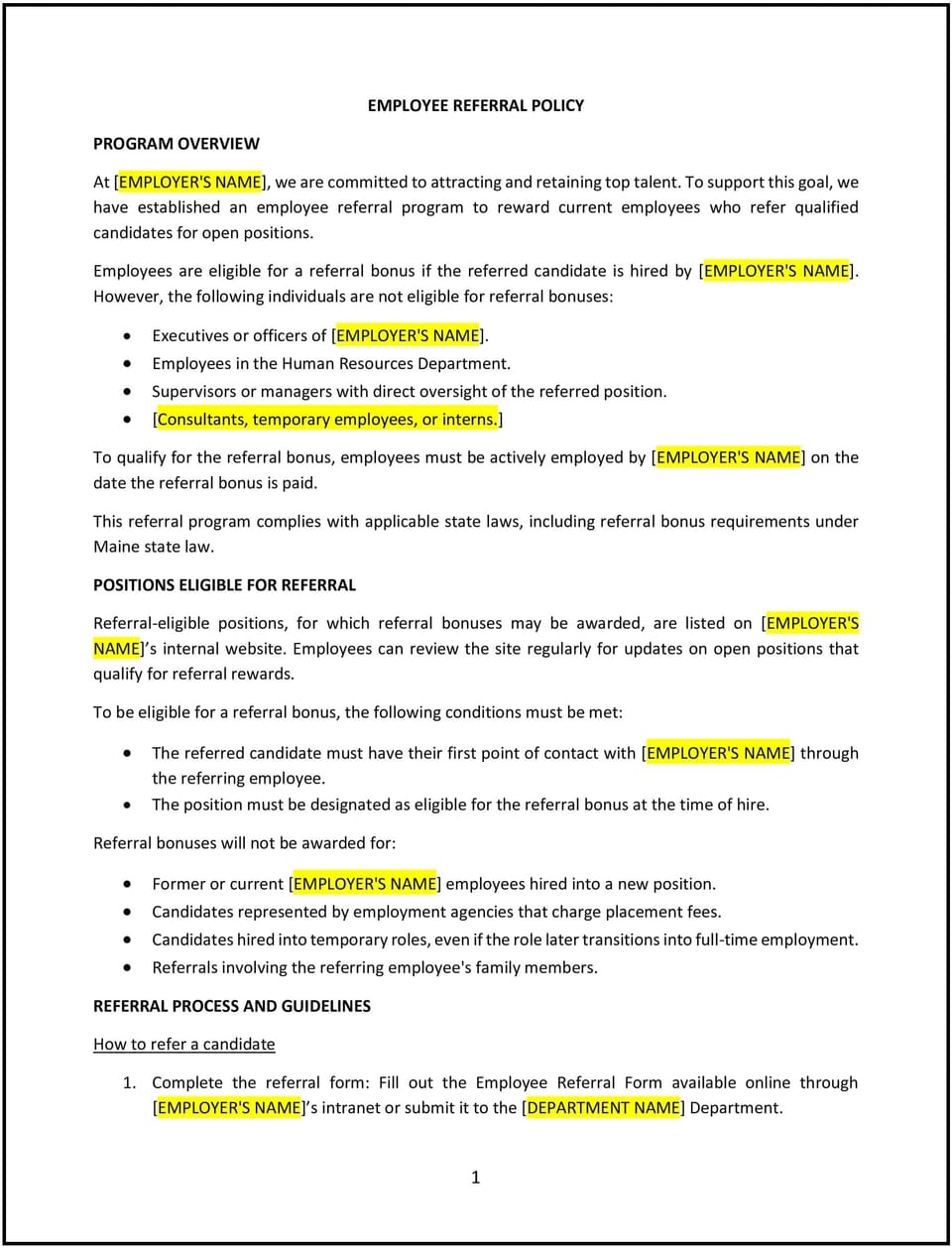Employee referral policy (Maine): Free template

Employee referral policy (Maine): Free template
This employee referral policy is designed to help Maine businesses encourage their employees to recommend qualified candidates for open positions. It outlines the eligibility criteria, referral process, and rewards structure, creating an effective and transparent system for leveraging employee networks in recruitment efforts.
By implementing this policy, Maine businesses can enhance recruitment efforts, improve employee engagement, and attract top talent.
How to use this employee referral policy (Maine)
- Define eligibility: Specify which employees are eligible to participate in the referral program and any restrictions, such as management-level employees referring candidates for their teams.
- Outline referral process: Include instructions for submitting referrals, such as completing a form, providing contact details, and submitting the candidate’s resume.
- Detail rewards: Specify the rewards for successful referrals, such as monetary bonuses, gift cards, or additional time off, and the conditions for receiving these rewards.
- Establish evaluation criteria: Clarify the standards used to assess referred candidates and ensure fair consideration in the hiring process.
- Address exclusions: State any exclusions, such as referrals for temporary roles or specific job levels that are not eligible for rewards.
- Promote confidentiality: Ensure referred candidates’ details are handled with confidentiality throughout the recruitment process.
- Review regularly: Update the policy to reflect changes in hiring needs, reward structures, or Maine labor regulations.
Benefits of using this employee referral policy (Maine)
Implementing this policy provides several benefits for Maine businesses:
- Enhances recruitment: Leverages employee networks to attract qualified candidates.
- Improves retention: Increases employee engagement and satisfaction through active involvement in hiring efforts.
- Reduces hiring costs: Lowers reliance on external recruiters or job advertisements.
- Promotes cultural fit: Helps identify candidates who align with the company’s values and work environment.
- Ensures transparency: Establishes clear guidelines for participation and rewards, minimizing confusion.
Tips for using this employee referral policy (Maine)
- Communicate clearly: Share the policy with employees through internal communications and make it accessible in the employee handbook.
- Recognize participation: Publicly acknowledge employees who make successful referrals to encourage ongoing engagement.
- Set realistic rewards: Offer rewards that are meaningful but aligned with the business’s budget.
- Monitor program effectiveness: Track metrics like referral success rates and hiring timelines to evaluate the program’s impact.
- Foster inclusivity: Ensure the program is accessible to all employees and free from bias.
- Stay compliant: Review Maine labor laws to ensure the program adheres to regulations regarding incentives and hiring practices.
Q: Who is eligible to participate in the employee referral program?
A: All employees, except those involved in hiring decisions for a specific role or senior management, are typically eligible to participate.
Q: How should businesses handle referrals for candidates who are not selected?
A: Businesses should notify the referring employee and candidate respectfully, thanking them for their participation and encouraging future referrals.
Q: How often should businesses review their employee referral policy?
A: Businesses should review the policy annually or whenever there are changes to hiring needs, reward structures, or Maine labor laws.
Q: What rewards can businesses offer for successful referrals?
A: Rewards can include cash bonuses, gift cards, extra paid time off, or non-monetary recognition, as outlined in the policy.
Q: How can businesses ensure fairness in the referral process?
A: Businesses should evaluate all referred candidates using the same criteria as external applicants and ensure decisions are free from bias.
Q: What is the typical process for submitting a referral?
A: Employees usually complete a referral form, provide the candidate’s contact details, and submit their resume or LinkedIn profile.
Q: How can businesses measure the success of the referral program?
A: Businesses can track metrics like the number of referrals, the percentage of successful hires, and retention rates of referred employees.
This article contains general legal information and does not contain legal advice. Cobrief is not a law firm or a substitute for an attorney or law firm. The law is complex and changes often. For legal advice, please ask a lawyer.


